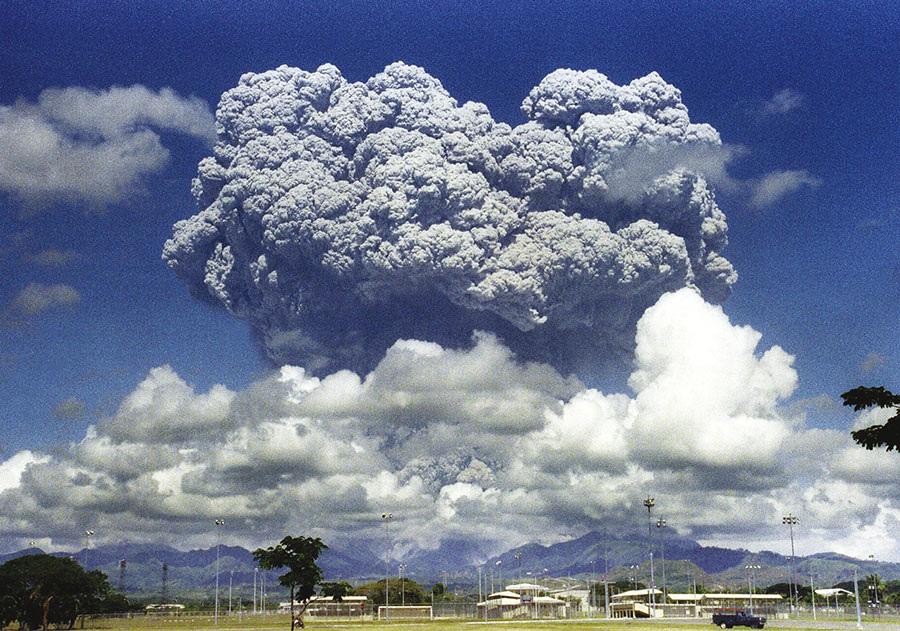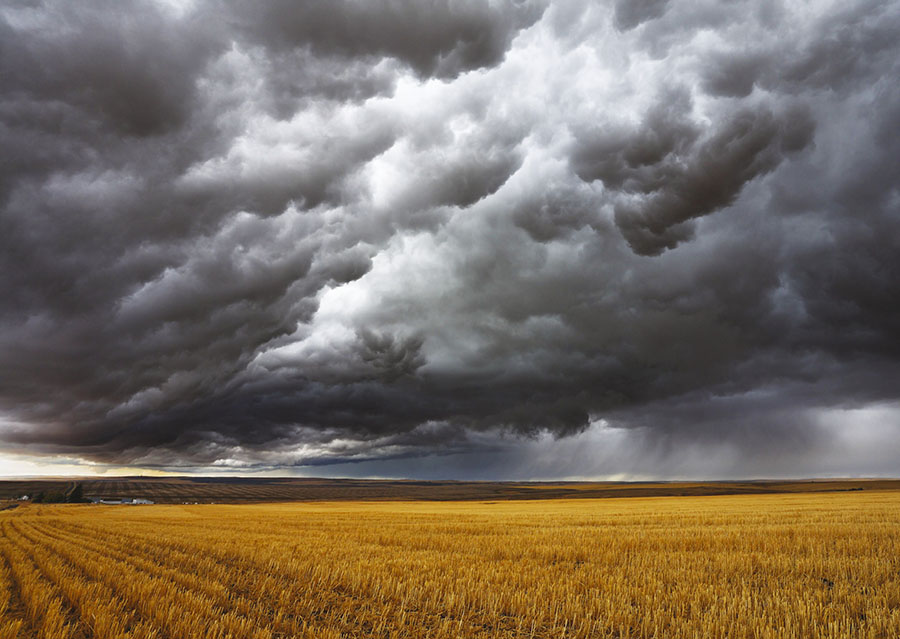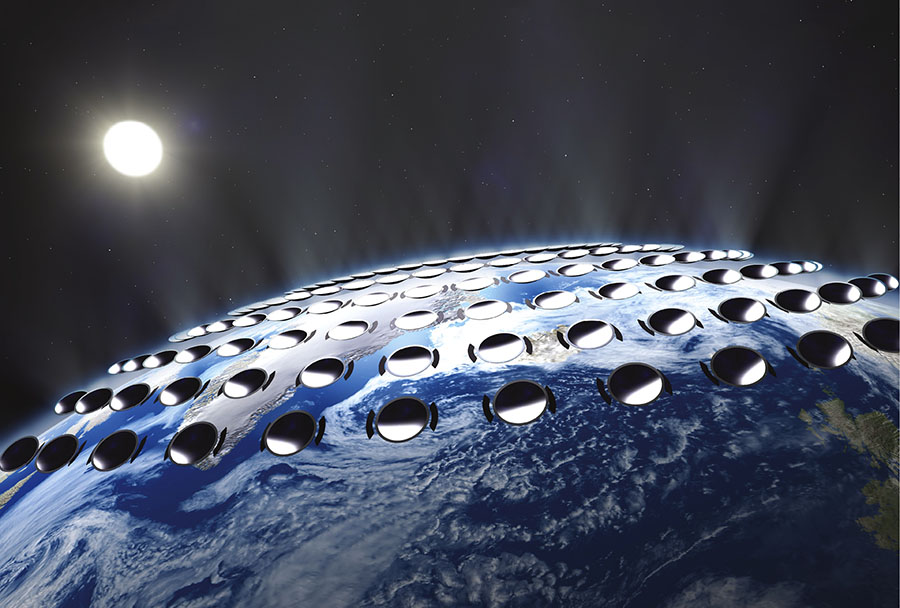Six
Shading the Planet
On June 12, 1991, a huge cloud of ash and gases blew out of the top of Mount Pinatubo, a volcano about 54 miles (87 km) northwest of Manila, the capital of the Philippines. The eruption was a strange and unexpected sight. Geologists had believed the volcano was dormant, or inactive, since it hadn’t erupted in the previous five hundred years. But the stream of gases and ash wasn’t the end of it. Three days later, on June 15, Mount Pinatubo erupted again. This time, the effect was devastating. An estimated 20 million tons (18 billion metric tons) of gases, particles, bits of dirt, and rock burst violently into the air, forming a balloon-shaped cloud that measured more than 249 miles (401 km) across and rose more than 22 miles (35 km) above the ground. Avalanches of molten lava, ash, and rock fragments poured down the sides of the volcano, covering the surrounding area and killing more than three hundred people.

Volcanic Mount Pinatubo, in the Philippines, explodes on June 12, 1991, sending millions of tons of ash, gas, and debris high into the atmosphere. The particles in the air reduced the amount of sunlight reaching Earth, leading to lower temperatures on the ground for more than two years. Scientists say that if we deliberately blasted particles into the air, we could imitate the effects of a volcano and reduce global temperatures to fight climate change.
The eruption also had worldwide consequences. The stream of volcanic ash and gases shot all the way into the stratosphere. High in the air, winds carried the substances around the planet. Geologists from the Philippine Institute of Volcanology and Seismology and the US Geological Survey used satellites to track and measure the ash and gases as they traveled. What the researchers learned astounded them. They noted a decrease in global temperatures of almost 1°F (0.6°C) for more than two years after the eruption.
What had happened? Volcanic ash contains many different components: fine particles of dirt and rocks, plus gases such as water vapor, carbon dioxide, hydrogen sulfide, and sulfur dioxide. Blasted high in the air, particles from a volcano form dark clouds that can block out sunlight. And when sulfur dioxide from a volcano reaches the stratosphere, it combines with water to form tiny droplets of sulfuric acid. The droplets stick together to produce an aerosol—a fine mist—which can stay in the stratosphere for up to three years. This mist also reflects the sun’s rays.
The combination of dark clouds and aerosols formed after a volcanic eruption cools Earth by blocking and reflecting sunlight, keeping it from reaching the ground. Climate scientists noted this cooling after the Mount Pinatubo eruption and realized that it might help solve Earth’s climate change problems. The idea they proposed is called solar radiation management (SRM).
Bounce Back
Like most other geoengineering concepts, SRM mimics a naturally occurring process. As the sun’s rays enter Earth’s atmosphere, about 30 percent of them immediately bounce back into space. The amount of solar radiation that returns to space is called the albedo. An increase in the albedo means that more radiation is being reflected. Larger albedo results in cooler global temperatures, since less heat from the sun reaches the surface of Earth. Climate scientists believe that by artificially increasing the albedo, they can drastically affect Earth’s climate and reduce global warming.
One idea is to simulate the way volcanic particulates act in the stratosphere to reflect sunlight. To do this, some climate scientists propose injecting particles of sulfur dioxide into the stratosphere. While this happens naturally during volcanic eruptions, climate scientists don’t know exactly how humans would pull it off.
For instance, what size of particles should be used? Large particles might be too heavy and could fall out of the atmosphere instead of turning into aerosols. Small particles might have no effect at all. And how would we get the particles into the air? Should we take them there in airplanes or balloons? Should we shoot them into the sky using rockets and exploding shells?
Assuming scientists figure out all that, the result would be a sulfuric acid cloud in the stratosphere. It would remain in place until winds move it around. Eventually, like all clouds, the sulfuric acid cloud would degrade, or break apart. In one year, it would be one-third its original size. After two years, it would be two-thirds its original size. To maintain constant cloud cover and ongoing cooling of Earth, we’d need to continue injecting new sulfur dioxide into the atmosphere. Some climate scientists have suggested that we’d need to inject 1 to 5 million tons (0.9 to 4.5 million metric tons) of sulfur dioxide into the stratosphere every year to reduce global temperatures. That would require an immense number of planes, rockets, balloons, or other vehicles. Estimates of the annual cost are between $25 and $50 billion.
Besides the high price tag, the proposal has other drawbacks. Adding huge amounts of sulfur dioxide to the atmosphere may increase acid rain, which can damage plants on the ground and harm life in the oceans. And the extra sulfur dioxide might create holes in the ozone layer of Earth’s atmosphere, allowing more of the sun’s radiation to reach Earth.
Another big question is how to control the amount of cooling that would occur with this kind of SRM. The goal is to lower the overall global temperature, but only to a certain point. If too much of the sun’s radiation is reflected, Earth could cool too rapidly. Finally, there is no way to predict exactly how clouds of sulfur dioxide will travel through Earth’s atmosphere, where they will go, and how they will affect precipitation patterns and other weather events. No one knows exactly which regions will benefit from the shading and which might suffer. Some models show that the technique might bring flooding to some parts of the globe while causing droughts in others.
In the Cloud
Another SRM technique involves increasing the albedo using thick puffy clouds. These too would reflect the sun’s rays and keep them from reaching Earth, thus cooling the planet. How do you make clouds big and puffy? One way is to seed them with acid. This makes the clouds produce more water vapor and makes them fluffier and more reflective.

Thick clouds reflect the sun’s rays back into space and reduce the amount of sunlight hitting Earth. One geoengineering idea involves deliberately thickening clouds to block sunlight and lower global temperatures.
Another option is called cloud brightening. It involves pumping seawater up into low-level clouds—between about 6,500 and 20,000 feet (1,981 to 6,100 m) above Earth. The salt in the seawater would increase the surface area of the water droplets within the clouds. With an increased surface area, the clouds would become more reflective, sending more light back into space. The salt particles would also make the clouds denser. A dense cloud takes longer to dissipate than an airy cloud, which means that it stays in the air longer, increasing albedo.
Mirrors in Space
One of the more aggressive forms of SRM involves placing one giant mirror or many tiny mirrors in space. The mirrors would move with Earth as it circled the sun, constantly reflecting the sun’s light away from our planet.
Dr. David Keith, a physicist at Harvard University near Boston, Massachusetts, has proposed building a giant mirror out of strands of woven aluminum. It would look kind of like a massive window screen. The mirror wouldn’t completely block sunlight. It would just filter it so that fewer rays reached Earth. Keith’s theory is that if even 1 percent of the sun’s rays were blocked, the mirror could fix Earth’s climate troubles. The problem is that it would take a mirror roughly the size of Greenland to do the job. The logistics and cost of building a mirror that big and getting it into space make the idea impractical.

We could reflect sunlight away from Earth by launching one giant mirror or many small mirrors into orbit. Many scientists dismiss this kind of geoengineering program, since it would be extremely difficult to implement and manage, and the cost would be in the trillions of dollars.
In 2006 Dr. Roger Angel of the University of Arizona, one of the world’s foremost experts on optics (the branch of physics dealing with the properties of light), suggested that instead of one giant mirror, we should deploy trillions of free-floating mirrors into space. The mirrors would work together to form a cloud that covered about half the diameter of Earth. A “cloud” of this magnitude would reflect about 2 percent of the sun’s radiation. In Angel’s proposal, each mirror would be about 2 feet (0.6 m) long and would weigh only as much as a butterfly. Angel has a plan for launching the mirrors into space over a span of ten years. The mirrors would be steered into position using solar power and would stay in place for up to fifty years.
Sounds a little like something you might see in a science fiction movie, right? That is what most other scientists think. The scientific community has shown little support for this kind of drastic maneuver, largely because no one knows how it would affect the planet. And the cost of creating and managing mirrors in space is estimated to be in the trillions of dollars. Still, support for this type of intervention is gradually increasing as the climate continues to heat up.
Pros—but Even More Cons
While SRM concepts are intriguing, most geoengineering advocates warn of drawbacks. They say that reflecting too much solar radiation could make Earth very cold, very quickly. It could also alter Earth’s weather patterns in unpredictable ways. For instance, Dr. Piers Forster, a professor of climate change at the University of Leeds in the United Kingdom, writes, “All [SRM] mechanisms would . . . likely have harmful side effects in some regions, with much higher or much lower rainfall amounts in some regions.” Increased acid rain and the creation of large ozone holes are other big risks. And using SRM to reduce the amount of sunlight coming to Earth’s surface will directly harm solar power initiatives. With less sunlight, solar panels will collect less solar energy to convert into heat and electricity, making solar energy less effective as an alternative to fossil fuels.
One of the biggest concerns with SRM is that it does not remove carbon dioxide from the atmosphere. Forster says, “Solar radiation management doesn’t change carbon emissions at all. It only reduces the planet’s temperature or reduces its warming rate. Even with SRM, carbon emissions go on warming the planet and will increase if society doesn’t change.”
Then, with SRM, humans don’t have to change their habits. They don’t have to cut back on fossil fuel use. And some consumers might argue that if SRM can lower Earth’s temperature back to normal, why use renewable energy? Why worry about how much carbon dioxide we are putting into the atmosphere?
That kind of thinking is not beneficial to the planet, climatologists say. Regardless of how much sun we might be able to reflect using SRM, reducing carbon emissions is crucial for the long-term health of the planet. Increased emissions don’t just raise Earth’s temperatures and alter its climate. They also cause smog, which is harmful to all living organisms. The excess carbon also alters the chemistry of ocean water and harms sea life.
Many scientists and government officials worry that if SRM measures are enacted, the push to reduce carbon emissions will disappear. People might abandon Earth-friendly initiatives, including the use of scrubbers that remove carbon dioxide from power plant smokestacks, eco-friendly electric cars, and reforestation efforts. Forster calls for a rational approach to solar radiation management. He says that SRM is “only worth considering if we also rapidly reduce CO2 [carbon dioxide] emissions at the same time, otherwise any benefits would be quickly lost to CO2 warming of the planet.”
Then there’s the question of whether SRM would be a practical, affordable long-term investment. SRM systems would be expensive to create and even more expensive to maintain. Computer models indicate that once any type of SRM is in place, the program would need to continue indefinitely. The models show that stopping SRM would cause an abrupt and drastic increase in the global temperature, possibly with devastating effects on Earth and its inhabitants.
Although it is controversial and might be dangerous, some researchers continue to explore the possibility of SRM. Advocates of SRM argue that it is a quick way to get the global climate issue under control. They note that while SRM may seem a bit scary, the reward might be worth the risk and should at least be investigated.
